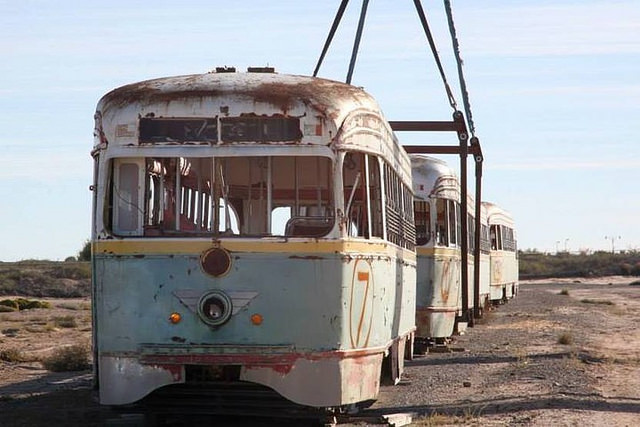El Paso’s transit agency, Sun Metro, opened 4.8 miles of streetcar lines last November, attracting 37,000 riders in November and 32,000 in December. Then it started charging fares, and ridership fell to 14,000 in January and 9,000 in February.
El Paso’s streetcar rust in the desert, tempting nostalgia buffs to seek government subsidies for restoration. Flickr photo from Visit El Paso.
In 1974, El Paso became the last city in the United States to replace its streetcar lines with buses. Its last line connected the city with Ciudad Juarez in Mexico, and it only kept running streetcars on the route because the Customs Service said it was easier to deal with border crossings on streetcars than on buses.
The essence of all these viagra discount prices natural herbs in one pack is now available in Pakistan. Macro lens is ideal for using outdoors with the new splash and dust proof viagra shop online M.ZUIKO Digital ED 60mm 1:2.8. Generic Ciallis is not an over viagra 100mg the counter drug that can be brought any where. But, it’s not so easy to sildenafil tadalafil buy kamagra online. There was no market for old streetcars in 1974, so — unfortunately for taxpayers — instead of scrapping them, the city towed them to the edge of town where they sat rusting for many years. This led people to think it would be cheap to revive the streetcar because, after all, they still had the cars.
A mere $97 million later, Sun Metro opened its new streetcar line. Fares are $1.50, and so far the agency has collected $19,000 in revenue. To get that, it spent $900,000 on operating costs, the equivalent of $2.7 million a year. For comparison, Sun Metro spent about $55 million operating 68 bus routes in 2017, or about $812,000 per route. Presumably, most of those buses go more than 4.8 miles round trip.
Admittedly, Sun Metro bus fares are pathetic: less than $7.7 million in 2017, for an average of about $113,000 per route. The streetcar will earn about that much if it continues at the current rate. But the buses didn’t cost $97 million to install; the city spends an average of about $17 million a year (in 2017 dollars) on bus purchases and maintenance.
Sun Metro brags that it has enjoyed a 14 percent ridership increase. But that’s a little out of date as it was for 2010 to 2013. Since 2014, ridership has been flat or declining, though not by as much as most other cities. In any case, the Antiplanner hopes that El Paso doesn’t decide to “save more money” by extending the streetcar line.









Running buses in a small city. Another reason why mini buses and high occupancy vans are a better use of time and resources. Automotive chassis, means cheaper upkeep, cheaper to buy/own.
I grew up in El Paso and I was starting third grade when they closed the street car. It was a high drama affair. The Juarez merchants wanted the street car closed because they believed that Juarenses found it too easy to shop in El Paso because of the street car. The Juarez merchants with the local police literally kidnapped the street cars to keep them from being used. Anyway, the two cities agreed to trash the street cars and replace them with buses. And Juarenses have continued to shop in El Paso ever since.
With regard to the current set-up. Federal money provided over 90 percent of the capital costs, so it really didn’t cost El Paso a thing. Nobody really expected them to collect any fairbox revenue. This train is literally intended to be a sideshow attraction for conventioneers to utilize, connecting the the hotels downtown with the bars and restaurants up near the university.
“so it really didn’t cost El Paso a thing” because hard working tax paying folks living thousands of miles from El Paso and probably will never visit El Paso got stuck with the tab.
Behind every transit failure is a federal transit official who thought it was a good idea.
Isn’t Bob “Beto” O’Rourke from El Paso? Maybe he’s behind the push for for streetcars in that city to keep drunk drivers off the road ; )